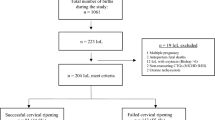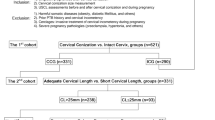Abstract
Objective:
To examine the risk of subsequent preterm birth after cervical ripening using a balloon catheter.
Study Design:
A retrospective study was held at a university teaching hospital between January 2007 and June 2013. The study group included women who underwent cervical ripening using a balloon (single or double) catheter in the previous pregnancy followed by a subsequent singleton delivery (balloon catheter group). Two control groups were included. The first was similar to the study group except that ripening was achieved in the previous pregnancy with vaginal prostaglandin E2 (PGE2 group). The second control group had a previous pregnancy that resulted in spontaneous onset of labor at term (unexposed group). The primary outcome was the incidence of spontaneous preterm birth (before 37 weeks) in the index pregnancy.
Result:
Overall, 558 women were included; each group consisted of 186 women. The incidence of spontaneous preterm birth in the index pregnancy did not differ between the groups (0.5, 1.6 and 2.7% in the balloon catheter, PGE2 and in the unexposed groups, respectively, P=0.31). Among the balloon catheter group, 58 (31.2%) women had the ripening performed with a single-balloon catheter and 128 (68.8%) women with a double-balloon catheter. The rate of the spontaneous preterm birth in the index pregnancy did not differ between the two groups (P=1.0).
Conclusion:
Cervical ripening with a balloon catheter does not increase the rate of subsequent spontaneous preterm birth.
This is a preview of subscription content, access via your institution
Access options
Subscribe to this journal
Receive 12 print issues and online access
$259.00 per year
only $21.58 per issue
Buy this article
- Purchase on Springer Link
- Instant access to full article PDF
Prices may be subject to local taxes which are calculated during checkout
Similar content being viewed by others
References
Goldenberg RL, Culhane JF, Iams JD, Romero R . Epidemiology and causes of preterm birth. Lancet 2008; 371: 75–84.
McCormick MC . The contribution of low birth weight to infant mortality and childhood morbidity. N Engl J Med 1985; 312: 82–90.
Hamilton BE, Hoyert DL, Martin JA, Strobino DM, Guyer B . Annual summary of vital statistics: 2010-2011. Pediatrics 2013; 1: 548–558.
Blencowe H, Cousens S, Oestergaard MZ, Chou D, Moller AB, Narwal R et al. National, regional, and worldwide estimates of preterm birth rates in the year 2010 with time trends since 1990 for selected countries: a systematic analysis and implications. Lancet 2012; 379: 2162–2172.
Chang HH, Larson J, Blencowe H, Spong CY, Howson CP, Cairns-Smith S et alBorn Too Soon preterm prevention analysis group. Preventing preterm births: analysis of trends and potential reductions with interventions in 39 countries with very high human development index. Lancet 2013; 381: 223–234.
Slattery MM, Morrison JJ . Preterm delivery. Lancet 2002; 360: 1489–1497.
American College of Obstetricians and Gynecologists Practice Bulletin No. 107: induction of labor. Obstet Gynecol 2009; 114: 386–397.
Boulvain M, Kelly A, Lohse C, Stan C, Irion O . Mechanical methods for induction of labour. Cochrane Database Syst Rev 2001; 4: CD001233.
Gelber S, Sciscione A . Mechanical methods of cervical ripening and labor induction. Clin Obstet Gynecol 2006; 49: 642–657.
Delaney S, Shaffer BL, Cheng YW, Vargas J, Sparks TN, Paul K et al. Labor induction with a Foley balloon inflated to 30mL compared with 60mL: a randomized controlled trial. Obstet Gynecol 2010; 115: 1239–1245.
Atad J, Hallak M, Ben-David Y, Auslender R, Abramovici H . Ripening and dilatation of the unfavourable cervix for induction of labour by a double balloon device: experience with 250 cases. BJOG 1997; 104: 29–32.
Salim R, Zafran N, Nachum Z, Garmi G, Kraiem N, Shalev E . Single-balloon compared with double-balloon catheters for induction of labor: a randomized controlled trial. Obstet Gynecol 2011; 118: 79–86.
Manabe Y, Manabe A, Takahashi AF . Prostaglandin levels in amniotic fluid during balloon induced cervical softening and labor at term. Prostaglandins 1982; 23: 247–256.
Levine LD, Bogner HR, Hirshberg A, Elovitz MA, Sammel MD, Srinivas SK . Term induction of labor and subsequent preterm birth. Am J Obstet Gynecol 2014; 210: 354.e1–354.e8.
Sciscione A, Larkin M, O'Shea A, Pollock M, Hoffman M, Colmorgen G . Preinduction cervical ripening with the Foley catheter and the risk of subsequent preterm birth. Am J Obstet Gynecol 2004; 190: 751–754.
Martin JA, Hamilton BE, Sutton PD, Ventura SJ, Menacker F, Munson ML . Births: final data for 2003. Natl Vital Stat Rep 2005; 54: 1–116.
Suhag A, Berghella V . Cervical cerclage. Clin Obstet Gynecol 2014; 57: 557–567.
Levy R, Kanengiser B, Furman B, Ben Arie A, Brown D, Hagay ZJ . A randomized trial comparing a 30-mL and an 80-mL Foley catheter balloon for preinduction cervical ripening. Am J Obstet Gynecol 2004; 191: 1632–1636.
Kashanian M, Nazemi M, Malakzadegan A . Comparison of 30-mL and 80-mL Foley catheter balloons and oxytocin for preinduction cervical ripening. Int J Gynaecol Obstet 2009; 105: 174–175.
Acknowledgements
We thank Naama Schwartz, biostatistician, MA, Emek Medical Center, Afula, Israel, for assisting in the statistical analysis.
Author information
Authors and Affiliations
Corresponding author
Ethics declarations
Competing interests
The authors declare no conflict of interest.
Rights and permissions
About this article
Cite this article
Zafran, N., Garmi, G., Zuarez-Easton, S. et al. Cervical ripening with the balloon catheter and the risk of subsequent preterm birth. J Perinatol 35, 799–802 (2015). https://doi.org/10.1038/jp.2015.69
Received:
Revised:
Accepted:
Published:
Issue Date:
DOI: https://doi.org/10.1038/jp.2015.69



